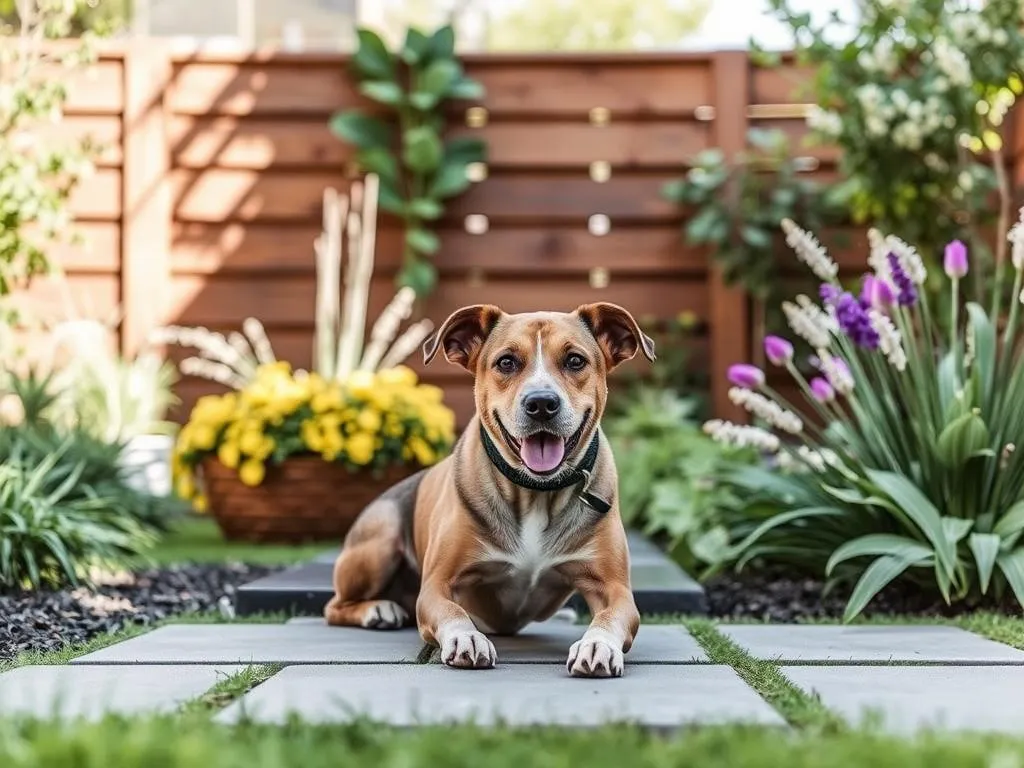
Introduction
Creating a dog-friendly backyard is essential for dog owners who want to provide their furry friends with a safe, fun, and engaging outdoor space. A well-designed backyard not only enhances your dog’s quality of life but also strengthens the bond between you and your pet. Dogs thrive in environments where they can explore, play, and relax, and a thoughtfully planned backyard can cater to all these needs.
The purpose of this article is to guide you through the steps of transforming your backyard into a haven for your dog. We will discuss planning, landscaping, safety, play areas, and maintenance, ensuring that your outdoor space is a joy for both you and your canine companion.
Planning Your Dog-Friendly Backyard
Assess Your Space
Before diving into the design, it’s important to assess your available space. Start by measuring your backyard dimensions to understand how much room you have to work with. Take note of existing features such as trees, shrubs, and fences. These elements can influence your design and provide natural shade and shelter for your dog.
Consider your local climate and environment. If you live in a hot area, you’ll want to prioritize shade and water access, while colder climates may necessitate weather-resistant shelters and safe play areas for winter months.
Understanding Your Dog’s Needs
Each dog is unique, and understanding your pet’s specific needs is crucial when creating a dog-friendly backyard. Consider your dog’s breed, size, and energy level. High-energy breeds may require more space to run and play, while smaller or older dogs might need quieter areas for relaxation.
Keep in mind any age-related or health conditions your dog may have. Older dogs may need softer surfaces to lay on, while puppies will benefit from areas designated for training and socialization. By tailoring your backyard to your dog’s needs, you ensure a safe and engaging environment.
Setting Goals for Your Backyard
Setting clear goals for your dog-friendly backyard will help you prioritize design elements. Think about the primary purposes of the space: do you want an area for play, relaxation, training, or socialization? Defining these goals will guide your design choices and help create a backyard that is both functional and enjoyable for your dog.
Safety and comfort should always come first. Make sure to eliminate any potential hazards and provide comfortable resting areas for your dog to retreat to after playtime.
Fencing and Boundaries
Choosing the Right Fence
A secure fence is a crucial element in creating a dog-friendly backyard. It not only keeps your dog safe but also prevents them from wandering off or encountering unwanted wildlife. When selecting a fence, consider the materials—wood, vinyl, and chain-link are common options. Each material has its pros and cons, so choose one that suits your aesthetic and functional needs.
Height is another factor to consider. Depending on your dog’s size and jumping ability, a taller fence may be necessary. Additionally, research local regulations and restrictions regarding fencing to ensure compliance.
Creating Safe Boundaries
Once you’ve installed a fence, focus on creating secure boundaries within your backyard. Ensure gates have sturdy latches that your dog cannot manipulate. Implement strategies to prevent digging or jumping, such as burying fence materials underground or adding barriers.
Consider your neighbors and local wildlife when designing your boundaries. If your dog is prone to barking at passing animals or people, you may want to plant dense shrubs or install sound barriers to minimize distractions.
Dog-Friendly Landscaping
Selecting Safe Plants
Landscaping is a key component of a dog-friendly backyard. When choosing plants and flowers, opt for non-toxic varieties that won’t harm your dog if ingested. Some safe options include:
- Marigolds
- Sunflowers
- Snapdragons
- Basil
- Rosemary
Avoid planting harmful species such as azaleas and lilies, which can be toxic to dogs. Additionally, create shaded areas using trees or large umbrellas to provide relief from the sun on hot days.
Grass and Ground Cover Options
If your dog loves to run and play, selecting the right type of grass is vital. Some of the best options for dog-friendly lawns include:
- Kentucky Bluegrass
- Perennial Ryegrass
- Fescue
Consider alternatives to traditional grass, such as clover or artificial turf, which can be more resilient to wear and tear caused by playful pups. Maintaining a dog-friendly lawn involves regular mowing, aerating, and watering.
Hardscaping Elements
Incorporating hardscaping elements like paths, patios, and seating areas can enhance your backyard’s functionality. Use materials that are safe for dogs—avoid sharp stones or hot surfaces that could hurt their paws. Opt for softer materials like mulch or gravel, which can provide comfort and improve drainage.
Creating Play Areas
Designing Play Zones
Designated play areas are essential for a dog-friendly backyard. Create zones where your dog can run, jump, and engage with toys. Consider adding agility equipment like tunnels, jumps, and weave poles to keep your dog physically active.
Interactive elements such as water features, kiddie pools, and digging zones can also provide added excitement. A sandbox or designated digging area can satisfy your dog’s natural instincts while keeping the rest of your yard intact.
Incorporating Natural Elements
Utilizing natural elements in your backyard can make it more engaging for your dog. Incorporate logs, rocks, and other obstacles for climbing and exploring. A sandpit can serve as a dedicated area for digging, allowing your dog to satisfy their curiosity without ruining your garden.
Consider creating a sensory garden with different textures, scents, and sounds to stimulate your dog’s senses. This can include fragrant herbs, rustling grasses, and interactive water features.
Safety Considerations in Play Areas
Safety is paramount in any dog-friendly backyard. Regularly inspect and maintain play equipment to ensure it’s in good condition. Choose non-toxic, durable toys that can withstand chewing and rough play. Always monitor your dog’s play areas for hazards such as sharp edges, choking risks, or toxic plants.
Comfort and Shelter
Providing Shade and Shelter
A well-designed backyard should include shaded areas to protect your dog from the sun. Consider building or purchasing a dog house or outdoor bed that offers comfort and protection from the elements. Ensure that the shelter is weather-resistant and spacious enough for your dog to lie down comfortably.
Water and Hydration
Hydration is crucial for your dog’s well-being, especially during play sessions. Always provide access to fresh water, whether through a bowl or a dog-friendly water feature. Kiddie pools can also be a fun way for your dog to cool off on hot days, so consider incorporating one into your backyard design.
Training and Socialization
Utilizing the Backyard for Training
Your dog-friendly backyard can serve as an excellent space for training. Use this area to practice basic obedience commands and reinforce good behavior. Designate a training zone where distractions are minimized, allowing your dog to focus on learning.
Employ positive reinforcement techniques, such as treats and praise, to motivate your dog during training sessions. The outdoor setting can also make training more enjoyable for both you and your pet.
Socialization with Other Dogs
Socialization is vital for a well-adjusted dog. Use your backyard to arrange controlled playdates with other dogs. Set up safe meeting areas where dogs can interact under your supervision. Monitor their interactions closely to ensure a positive experience and to prevent any aggressive behavior.
Maintenance and Care
Regular Upkeep
A dog-friendly backyard requires regular upkeep to remain safe and inviting. Make it a habit to clean up waste promptly to keep the space hygienic. Regular lawn maintenance, including mowing, aerating, and fertilizing, will help maintain a healthy environment for your dog.
Seasonal Adjustments
Adjust your backyard for seasonal changes to keep it dog-friendly year-round. In winter, ensure pathways are clear of snow and ice, and provide warm shelter for your dog. In summer, create shaded areas and ensure access to water. Being proactive about seasonal adjustments will keep your dog comfortable and safe, regardless of the weather.
Conclusion
Creating a dog-friendly backyard is a rewarding endeavor that benefits both you and your canine companion. By taking the time to plan, design, and maintain a safe and engaging outdoor space, you can enhance your dog’s happiness and well-being. Remember to prioritize safety, comfort, and fun, ensuring that your backyard is a place of joy for your furry friend.
As you embark on this journey, take actionable steps towards transforming your outdoor space. Your dog will thank you for it, and the joyful moments spent together in your dog-friendly backyard will only strengthen your bond.
Let your creativity flow as you design the perfect retreat for your beloved pet!









